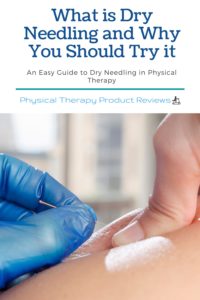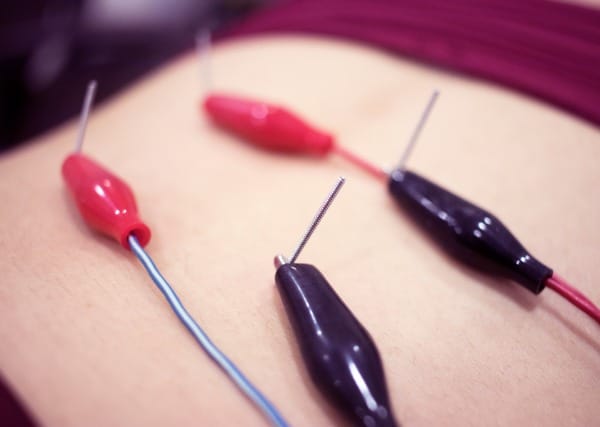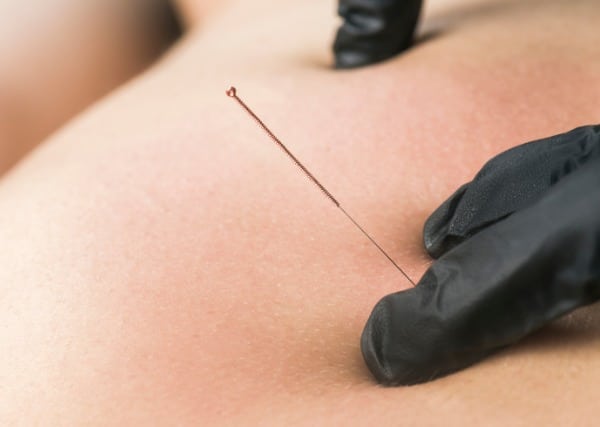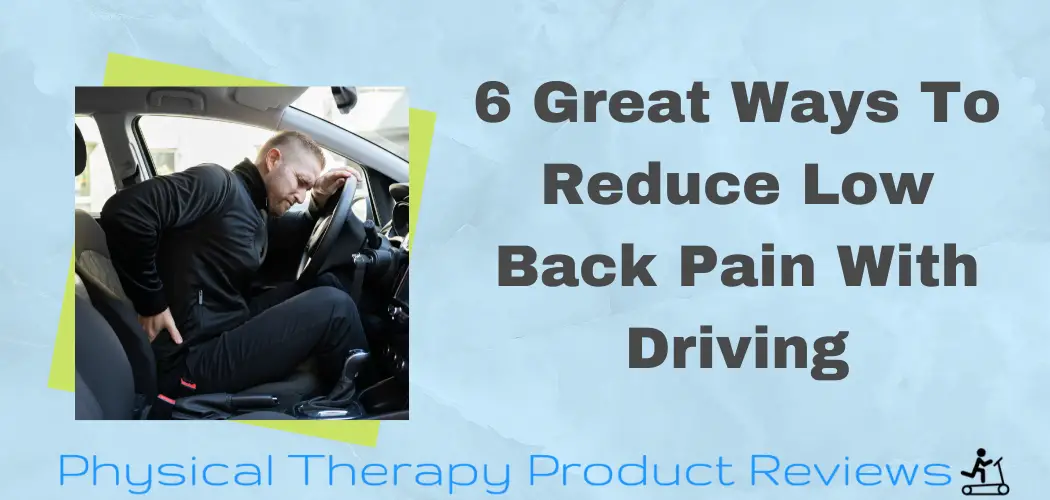There are many modalities used by physical therapists to help patients. Most commonly, a plan of care consists of a variety of techniques, activities, and treatments. One such application is the use of trigger point dry needling.
What is Dry Needling?
 Trigger point dry needling is a common and quickly growing treatment that physical therapists can employ as a part of a treatment plan. It is used in many settings and for many different types of musculoskeletal pain and dysfunction.
Trigger point dry needling is a common and quickly growing treatment that physical therapists can employ as a part of a treatment plan. It is used in many settings and for many different types of musculoskeletal pain and dysfunction.
First, the area is palpated to identify any uniquely tender or tight areas of muscle. We call these muscle knots “trigger points”. A very thin and flexible stainless steel needle is used to target these trigger points in an effort to produce a localized reaction of inflammation. This recruits more blood flow to the area to accelerate healing and can release those dense muscle knots, encouraging them to relax.
These trigger points are of concern because they are theorized to act like small localized muscle cramps.
Over time, these can cause hyper-sensitization, tenderness, and cascading effects of the disorder.
Now evident from recent research, we know that these myofascial trigger points are responsible for a large portion of patient complaints, even those with chronic issues. Trigger point dry needling may be just the treatment to affect those symptoms, thus allowing a patient to better perform with their rehab program.
How is Dry Needling Different from Acupuncture?
Though they seem similar, dry needling and acupuncture are vastly different. Acupuncture is based on the traditional Chinese belief of energy sources throughout the body. These energy sources are engaged with an acupuncture needle, usually multiple sets at the same time. Needles remain stagnant for most of the treatment, which can last upwards of 30 minutes.
In contrast, dry needling practice typically involves only one or two needles at a time and the clinician will thread the needle up and down around an identified trigger point for a minute or so. Dry needling treatment is much deeper into the muscle. The treatment time is much shorter and involves fewer needles.
Some treatments also include the use of an electrical stimulation device. In these cases, one or two needles are set into position, and the e-stim machine is attached to them to provide a low pulsing effect. Used in a variety of body regions, you’ll mostly see this employed for the lumbar regions of the lower back.

Is Dry Needling Safe?
Physical therapists are trained to conduct only evidence-based practice. The safety and efficacy of dry needling have been backed by a multitude of research. On top of having a professional medical degree, the use of dry needling requires an educational course and a certification process. As experts of the human body, physical therapists learn the areas that are safe to treat and those that are not.
Dry needling is a very safe procedure! The only tissues targeted are muscle fibers and tendons. The most common side effects include slight bruising and soreness. As expected from a treatment involving needles, some bleeding can occur at times, but it’s nothing a bandaid won’t fix.
What are the Benefits of Dry Needling
Dry needling treatment can provide immediate results. Unlike other modalities that can take weeks to show effect, patients often see changes in their pain or function directly following a dry needling session. This result can not only reduce the amount of time a patient spends in pain, but also the amount of time they need to spend in rehab addressing their symptoms. Dry needling is used for many conditions, be it acute or chronic.
Needling can be a useful treatment for patients that haven’t responded to other forms of care. Stubborn symptoms and conditions can see greater effects with dry needling treatments than they might’ve been able to with therapeutic exercise alone.
Does Dry Needling Hurt?
All patients will experience this treatment differently. Mostly, you may feel some soreness or “toothache” like pain at the site of insertion. Engaging an active trigger point can also cause a muscle twitch or spasm, which may surprise you. But, it’s a good sign! Those muscle reactions mean that the trigger point has been engaged, and that’s exactly the goal with dry needling.
After your needling session, you may feel muscle soreness at the site of treatment. It’s typically advised to continue stretching and drinking water throughout the day. You’ll likely feel as though you just completed a tough workout!
If at any point, you feel as though you’re experiencing sharp pain, communicate that to your therapist and they will cease treatment. The procedure won’t be as effective if you are in significant pain, so it’s best to avoid that.

Why Should You Try Dry Needling
Dry needling can be an excellent supplement to your plan of care! It’s incredibly effective at treating stubborn conditions, chronic pain, and acute symptoms. Providing fast and significant results, you’ll be able to return to prior function quicker and easier.
Combined with a complete plan, needling can provide a symptom-kicking boost that your rehab needs to progress forward. While treating those pesky trigger points with a targeted approach, it’s very beneficial to continue addressing weaknesses and lack of mobility with therapeutic exercise as well.
You should not try dry needling if you are incredibly wary of needles, are on blood thinners, or can barely stand light touch over your painful area. Though it’s a potent treatment procedure, it’s still not for everyone.
FAQ About Dry Needling
Does Dry Needling Feel Good?
It definitely can! During the treatment there is a dull ache similar or even less than a flu shot ache. However, once the treatment is complete there is often a feeling of immediate looseness and of endorphin rush. This can make the body feel good especially when there are high levels of pain to start with.
How Long Does It Take for Dry Needling to Work?
Dry needling can begin to have a positive effect nearly immediately but this isn’t always the case. It’s most common to feel something different within 24-48 hours after treatment.
Does Dry Needling Damage Muscles?
No, it doesn’t create lasting muscle change. There may be immediate muscle soreness and even temporary bruising. In the current research, it took over 5 days in a row of continue needling in a muscle before there was any signs of muscle damage.
How Long Does Dry Needling Soreness Last?
The post dry needling soreness is expected for 24-72 hours after treatment. This includes achiness and sometimes stiffness. To help reduce this, we recommend staying active with cardiovascular exercise, stretching, and using a hot pack.
How Does Dry Needling Help With Pain?
Needling decreases pain by changing the activity of the nervous system. By altering and influencing how the nerves communicate with the brain, it changes the pain response.
How Long. Does a Dry Needling Session Take?
Most of the time a dry needling session will take between 15-30 minutes. This depends on how many muscles being needling and multiple other factors. On top of that, it’s recommended to do correct exercises after needling so the full session could take between 15 minutes – 1 hour depending on the case.
Conclusion
Trigger point dry needling is a safe and effective treatment that has been used by physical therapists for decades. It can be an excellent addition to your plan of care and provide a supplemental remedy to reduce your symptoms. Discuss adding in needling treatment with your therapist, and enjoy your faster pain relief and quicker return to function!
Other Great Rehab Related Articles
Dealing with Painful Stairs After Ankle Replacement Surgery
Walking After a Total Ankle Replacement: Tips for a Successful Recovery
Exercises While Non-Weight Bearing After Ankle Replacement: Elevation, AROM, Leg Raises, and More
Ankle Pain with Stairs: Causes and Home Treatment Options
5 Common Mistakes You’re Making After an Ankle Sprain
6 Great Ways to Reduce Low Back Pain with Driving
Disclaimer: The information provided in this post is for educational purposes only. This is not a substitute for a medical appointment. Please refer to your physician before starting any exercise program.






